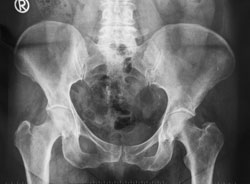
Hip Dysplasia
 Hip dysplasia, also known as developmental dysplasia of the hip, refers to problems with the formation of the hip joint in children. These problems can occur within the ball (femoral head), socket (acetabulum) or both components of the joint. The most common form of hip dysplasia involves a socket that is too shallow, forcing the leg to place excessive pressure on it.
Hip dysplasia, also known as developmental dysplasia of the hip, refers to problems with the formation of the hip joint in children. These problems can occur within the ball (femoral head), socket (acetabulum) or both components of the joint. The most common form of hip dysplasia involves a socket that is too shallow, forcing the leg to place excessive pressure on it.
Hip dysplasia can affect one or both hips, and may be mild or severe. Mild cases result in a hip that is unstable and prone to dislocation, while severe cases involve a hip joint that is permanently dislocated, either partially or fully.
Children with hip dysplasia are often born with this condition, or develop it within the first few years of life. The exact cause is unknown, but some babies are at a higher risk of having this condition. Some of these risk factors may include:
- Family history of hip dysplasia
- Born in breech position
- Born with other problems as a result of the position in-utero
- Lack of intrauterine fluid
While children with this condition may not experience any symptoms, hip dysplasia can lead to major problems later in life, which is why thorough treatment is recommended as soon as possible.
Treatment for hip dysplasia can vary depending on the age of the child and the severity of the condition. Nonsurgical treatment is often the first step in correcting this condition, and may involve a Pavlik harness to prevent the hip from moving out of the socket or a spica cast in older children which restricts movement even more. Surgery may be required for older children to move the hip joint back into its proper position. Your doctor will decide which treatment is best for you child to help prevent future problems such as arthritis.
Perthes Disease
Perthes disease, also referred to as Legg-Calve-Perthes disease, is a condition that involves a temporary loss of blood supply to the hip, causing the ball (femoral head) of the ball and socket joint to die. When the blood supply eventually returns, the bone heals, but can lead to serious problems later in life. This condition is most common in boys between the age of four and eight.
Children with this condition experience discomfort as a result of inflammation and irritation. This discomfort is most often experienced in the knees, and may cause an abnormal gait as well. Discomfort is usually worse when the hip is moved.
Since Perthes disease can affect the structure of the hip, it is important to seek medical attention for this condition as early as possible to help treat it properly and prevent complications.
The best treatment for Perthes disease depends on the age and gender of the child, along with the severity of the condition. In many cases, especially in younger children, no treatment is necessary and the condition will correct itself. Anti-inflammatory medication can help relieve symptoms. Other cases are treated with nonsurgical techniques such as traction and immobilization, while the most severe cases may require surgery to restore movement to the hip joint. Physical therapy is beneficial to most Perthes disease patients in order to promote proper healing.
Perthes disease does not usually last more than two years, and most patients will continue to grow with no major physical limitations from this condition.
Clubfoot
Clubfoot is a common childhood condition that causes the foot to turn inward to the side, resembling the head of a golf club. This condition is present at birth and can affect one or both feet. It is usually an isolated condition that does not cause any other health problems for the child. But if left untreated, clubfoot can cause arthritis and issues with self-confidence as the child continues to grow.
The cause of clubfoot is unclear, but is believed to be a result of congenital abnormalities or a genetic defect. While it may seem like a painful and serious condition, clubfoot does not typically cause any symptoms in patients, until they try to walk on it. It is most effective to treat this condition before the child is able to walk, in order to prevent symptoms and complications from occurring.
Clubfoot treatment often begins with nonsurgical methods such as manipulation and casting. The foot is manipulated into the correct position and then placed in a cast to stay in the corrected position.
When nonsurgical techniques are unsuccessful, surgery may be required to correct clubfoot. Surgery for this condition is usually performed when the child is 9 to 12 months old and involves adjusting the tendons, ligaments and joints in the foot and ankle to keep it in a corrected position.


